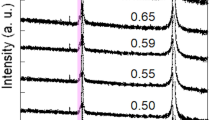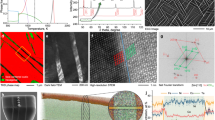Abstract
Magnetic materials are classed as ‘soft’ if they have a low coercivity (the critical field strength Hc required to flip the direction of magnetization). Soft magnetic materials are a central component of electromagnetic devices such as step motors, magnetic sensors, transformers and magnetic recording heads. Miniaturization of these devices requires materials that can develop higher saturation flux density, Bs, so that the necessary flux densities can be preserved on reducing device dimensions, while simultaneously achieving a low coercivity. Common high-Bs soft magnetic films currently in use are electroplated CoFe-based alloys1,2,3,4 electroplated CoNiFe alloys5,6,7 and sputtered Fe-based nanocrystalline8,9,10,11 and FeN films12,13,14. Sputtering is not suitable, however, for fabricating the thick films needed in some applications, for which electrochemical methods are preferred. Here we report the electrochemical preparation of a CoNiFe film with a very high value of Bs (2.0–2.1 T) and a low coercivity. The favourable properties are achieved by avoiding the need for organic additives in the deposition process, which are typically used to reduce internal stresses. Our films also undergo very small magnetostriction, which is essential to ensure that they are not stressed when an external magnetic field is applied (or conversely, that external stresses do not disrupt the magnetic properties). Our material should find applications in miniaturization of electromechanical devices and in high-density magnetic data storage.
This is a preview of subscription content, access via your institution
Access options
Subscribe to this journal
Receive 51 print issues and online access
$199.00 per year
only $3.90 per issue
Buy this article
- Purchase on Springer Link
- Instant access to full article PDF
Prices may be subject to local taxes which are calculated during checkout



Similar content being viewed by others
References
Liao, S. H. High moment CoFe thin films by electrodeposition. IEEE Trans. Magn. MAG-23, 2981–2983 (1987).
Chang, J. W., Andricacos, P. C., Petek, B. & Romankiw, L. T. in Proc. Symp. on Magnetic Materials, Processes and Devices (eds Romankiw, L. T. & Herman, D. A. Jr) 361–372 (PV90-8, Electrochem. Soc., Pennington, NJ, 1990).
Shinoura, O. & Kamijima, A. Magnetic properties of electrodeposited CoFe film. J. Surf. Finishing Soc. Jpn 44, 1114–1118 (1993).
Chang, J. W., Andricacos, P. C., Petek, B. & Romankiw, L. T. in Proc. 2nd Int. Symp. on Magnetic Materials, Processes, and Devices (eds Romankiw, L. T. & Herman, D. A. Jr) 275–287 (PV92-10, Electrochem. Soc., Pennington, NJ, 1992).
Anderson, N. C. & Chesnutt, R. B. Electrodeposition bath for cobalt-nickel-iron alloys for thin-film heads.US Patent no. 4,661, 216 (1987).
Omata, Y. Magnetic Properties of Fe-Co-Ni Films with High Saturation Magnetization Prepared by Evaporation and Electrodeposition 23–29 (Tech. Rep. MR-23, 23–29, (1988)).
Shinoura, O., Kamijima, A. & Narumiya, Y. Soft magnetic properties of electrodeposited CoNiFe films. J. Magn. Soc. Jpn. 18, 277–280 (1994).
Yoshizawa, Y., Oguma, S. & Yamauchi, K. New Fe-based soft magnetic alloys composed of ultrafine grain structure. J. Appl. Phys. 64, 6044–6046 (1988).
Ishiwata, N., Wakabayashi, C. & Urai, H. Soft magnetism of high-nitrogen-concentration FeTaN films. J. Appl. Phys. 69, 5616–5618 (1991).
Hasegawa, N. & Saito, M. Soft magnetic properties of microcrystalline Fe-M-C (M = V, Nb, Ta) films with high thermal stabiity. J. Magn. Soc. Jpn 14, 313–318 (1990).
Makino, A., Suzuki, K., Inoue, A. & Masumoto, T. Soft magnetic properties of bcc Fe-Zr-B sputtered films with nanoscale grain size. Mater. Trans. Jpn Inst. Metals 33, 80–86 (1992).
Takahashi, M., Shoji, H., Abe, M., Komaba, H. & Wakiyama, T. Soft magnetic preparation of Fe-N thin films sputtered in Ar + N2 plasma. J. Magn. Soc. Jpn 14, 283–288 (1990).
Wang, S. & Kryder, M. H. RF-diode-sputtered iron nitride films for thin-film recording head materials. J. Appl. Phys. 67, 5134–5136 (1990).
Ogura, T., Kume, M. & Kuroki, K. Soft magnetic properties and domain structure of Fe-N-O thin films for thin film head applciations. J. Magn. Soc. Jpn 18(S1), 195–198 (1994).
Wolf, I. W. Electrodeposition of magnetic materials. J. Appl. Phys. 33, 1152–1159 (1962).
Long, T. R. Electrodeposited memory element for a nondestructive memory. J. Appl. Phys. 31(suppl.), 123–124 (1960).
Romankiw, L. T. Electroformation of electronic devices. Plating Surf. Finish. 84, 10–16 (1997).
Smith, R. S., Godycki, L. E. & Lloyd, J. C. Effect of saccharin on the structural and magnetic properties of iron-nickel films. J. Electrochem. Soc. 108, 996–998 (1961).
Edwards, J. Radiotracer study of addition agent behaviour: 2-adsorption on metal surface from solutions containing thiourea. Tran. Inst. Met. Finish. 39, 45–51 (1962).
Edwards, J. Radiotracer study of addition agent behaviour: 3-incorporation of sulphur in nickel deposited from solutions containing p-toluenesulphonamide and saccharin. Tran. Inst. Met. Finish. 39, 52–55 (1962).
Brown, H. Addition agents, anions, and inclusions in bright nickel plating. Plating 55, 1047–1055 (1968).
Nakamura, A., Takai, M., Hayashi, K. & Osaka, T. Preparation and magnetic properties of CoNiFe thin film by electrodeposition. J. Surf. Finish. Soc. Jpn 47, 934–938 (1996).
Takai, M., Hayashi, K., Aoyagi, M. & Osaka, T. Electrochemical preparation of soft magnetic CoNiFeS film with high saturation magnetic flux density and high resistivity. J. Electrochem. Soc. 144, L203–L204 (1997).
Ohashi, K. et al. Newly developed CoNiFe film for MR head.Paper no. DQ-09, presented at the 7th Joint MMM-Intermag Conf., San Francisco, January (1998).
Roundtable Discussion about the Future of Magnetic Storage, SessionZA-0, Presented at the 7th Joint MMM-Intermag Conf., SanFrancisc, January 1998.
Powers, J. V. & Romankiw, L. T. Electroplating Cell Including Means to Agitate the Electrolyte in Laminar FlowUS Patent no. 4,652,442 (1972)).
Calcagno, P. A. & Thompson, D. A. Semiautomatic permeance tester for thick magnetic films. Rev. Sci. Instrum. 46, 904–908 (1975).
Acknowledgements
We thank Y. Okinaka, Waseda University, for discussions. This work was supported by a Research for Future Project of the Japan Society for Promotion of Science, a Grant-in-Aid for Scientific Research on Priority Area from the Ministry of Education, Science, Sports and Culture, Japan, and the Storage Research Consortium (SRC).
Author information
Authors and Affiliations
Corresponding author
Rights and permissions
About this article
Cite this article
Osaka, T., Takai, M., Hayashi, K. et al. A soft magnetic CoNiFe film with high saturation magnetic flux density and low coercivity. Nature 392, 796–798 (1998). https://doi.org/10.1038/33888
Received:
Accepted:
Published:
Issue Date:
DOI: https://doi.org/10.1038/33888
This article is cited by
-
Strong and ductile high temperature soft magnets through Widmanstätten precipitates
Nature Communications (2023)
-
A mechanically strong and ductile soft magnet with extremely low coercivity
Nature (2022)
-
Rapid multiple property determination from bulk materials libraries prepared from chemically synthesized powders
Scientific Reports (2022)
-
Magnetization–structure–composition phase diagram mapping in Co-Fe-Ni alloys using diffusion multiples and scanning Hall probe microscopy
Scientific Reports (2022)
-
Impact of Si and Mg on Microstructural and Magnetic Behavior of Fe-Co-Ni (Mg-Si)x (x = 0.00,0.1,0.2) Multicomponent Alloys
Silicon (2020)
Comments
By submitting a comment you agree to abide by our Terms and Community Guidelines. If you find something abusive or that does not comply with our terms or guidelines please flag it as inappropriate.



